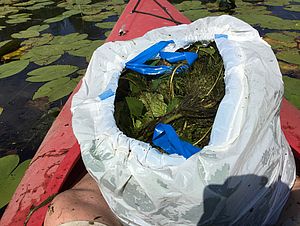LCC Finds Water Chestnut During Invasives Surveys

LCC bagged 109 invasive water chestnut rosettes in Lake Alice earlier this month. Photo by Mike Winslow.
For several years LCC has collaborated with Arrowwood Environmental to conduct surveys for aquatic invasive species in the Lake Champlain watershed. Our most recent efforts have focused on floating-leaved species like water chestnut. This year's work revealed two previously unknown populations of this pernicious invader: one on Alice Lake in Chazy, New York and the other in the marshes at the head of Vermont's St. Albans Bay. LCC Staff Scientist Mike Winslow removed 109 water chestnut plants from Alice Lake in the hopes of quashing the population before it becomes established. Soon he'll head to St. Albans Bay to undertake a removal effort there.
According to Vermont Invasives, water chestnut was first recorded in Lake Champlain in the 1940s and it has since spread throughout the lake and to 22 other bodies of water within Vermont. This annual aquatic plant can form dense monocultures, outcompeting beneficial native plant species, reducing oxygen levels, negatively altering the recreation potential of the invaded water body, and reducing shoreline property values. Since it is an annual species, population control measures are accomplished by removing the plant before it drops its seeds. Since the early 1980s, the Vermont Department of Environmental Conservation, with support from the US Army Corps of Engineers, has run a harvesting program to control the spread of water chestnut in Lake Champlain and prevent its introduction to other areas. Millions of dollars have been spent to control its spread.
LCC's invasive species surveys and eradication work are funded through a grant from the Lake Champlain Basin Program.
